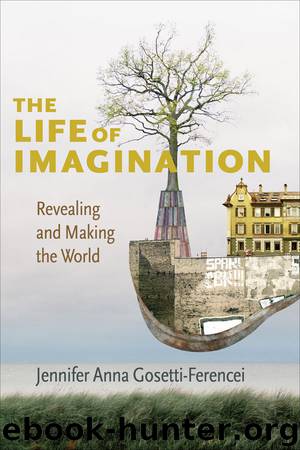The Life of Imagination by Jennifer Anna Gosetti-Ferencei & Jennifer Anna Gosetti-Ferencei

Author:Jennifer Anna Gosetti-Ferencei & Jennifer Anna Gosetti-Ferencei [Gosetti-Ferencei, Jennifer Anna]
Language: eng
Format: azw3
ISBN: 9780231189088
Publisher: Columbia University Press
Published: 2018-10-29T16:00:00+00:00
Given the embodiment of imagination, as these considerations of performative, visual, and literary arts have suggested, it may seem paradoxical that imagination’s most explicitly embodied manifestations can be interpreted as efforts to transcend embodied life, to leave the physical world behind. Petit’s aerial walk, the literalization of embodied imagining described at the outset of this chapter, echoes the dream that inspired the myth of Icarus, who flew too close to the sun on wax wings, or that of Leonardo da Vinci as he worked tirelessly toward the aim of human flight, or of the ancient Nazca artists of Peru, whose monumental carvings of birds, animals, insects, and other patterns could be properly viewed only from the sky. Throughout human history, in our ancient mythologies, our imagination has engaged the dream of outwitting the rootedness of our material existence. Wordsworth’s wandering cloud, and even Rilke’s more mundane rendering of a ball in flight, echo such imaginative ascensions.
Yet however much imagination virtually frees us from material constraints, it emerges from embodied life and is in turn experienced through an embodied mind. The body serves as the ground of human imagining in multiple ways, evidenced most manifestly in the arts for which embodied performance is central, dance and theatrical gesture, among others. Imagination is embodied not only when we undertake but also when we witness physical performances, as much as when we feel empathy on behalf of others, probe through painting the visual presence of the world, undergo the kinesthetic and sensory evocations of literature. Creative expressions of imagination may generate perspectives that transcend, but thereby index as well, the limitations of embodiment. While the body conducts its ordinary exercises of habitual life, it may be engaged in other transformative activities of imagining. Whereas in ordinary everyday experience the body is “restricted to the actions necessary for the conservation of life,” as Merleau-Ponty suggests, we can find the body “at other times elaborating upon the primary actions and moving from their literal to their figurative meaning”—and when it does so “it manifests through them a new core of significance.”67 While our ordinary embodiment underlies the vitality, coherence, and form of human experience, the body may also extend us, in and through activities of imagination, beyond ordinary life.
Download
This site does not store any files on its server. We only index and link to content provided by other sites. Please contact the content providers to delete copyright contents if any and email us, we'll remove relevant links or contents immediately.
Rewire Your Anxious Brain by Catherine M. Pittman(17580)
Talking to Strangers by Malcolm Gladwell(11859)
The Art of Thinking Clearly by Rolf Dobelli(8836)
Mindhunter: Inside the FBI's Elite Serial Crime Unit by John E. Douglas & Mark Olshaker(7827)
Becoming Supernatural by Dr. Joe Dispenza(7099)
Change Your Questions, Change Your Life by Marilee Adams(6635)
Nudge - Improving Decisions about Health, Wealth, and Happiness by Thaler Sunstein(6629)
The Road Less Traveled by M. Scott Peck(6626)
The Lost Art of Listening by Michael P. Nichols(6461)
Enlightenment Now: The Case for Reason, Science, Humanism, and Progress by Steven Pinker(6402)
Win Bigly by Scott Adams(6306)
Mastermind: How to Think Like Sherlock Holmes by Maria Konnikova(6224)
The Way of Zen by Alan W. Watts(5787)
Daring Greatly by Brene Brown(5636)
Grit by Angela Duckworth(4728)
Big Magic: Creative Living Beyond Fear by Elizabeth Gilbert(4717)
Men In Love by Nancy Friday(4314)
Flow by Mihaly Csikszentmihalyi(4045)
The Four Tendencies by Gretchen Rubin(4014)
